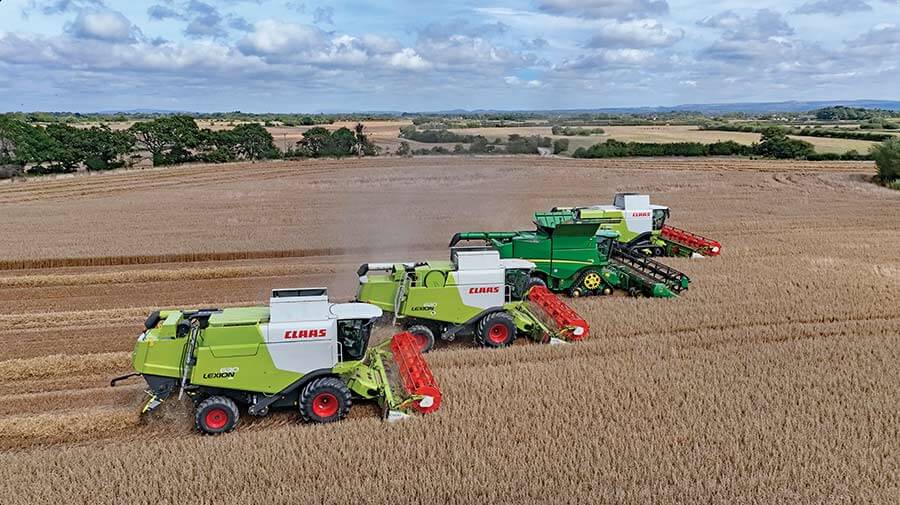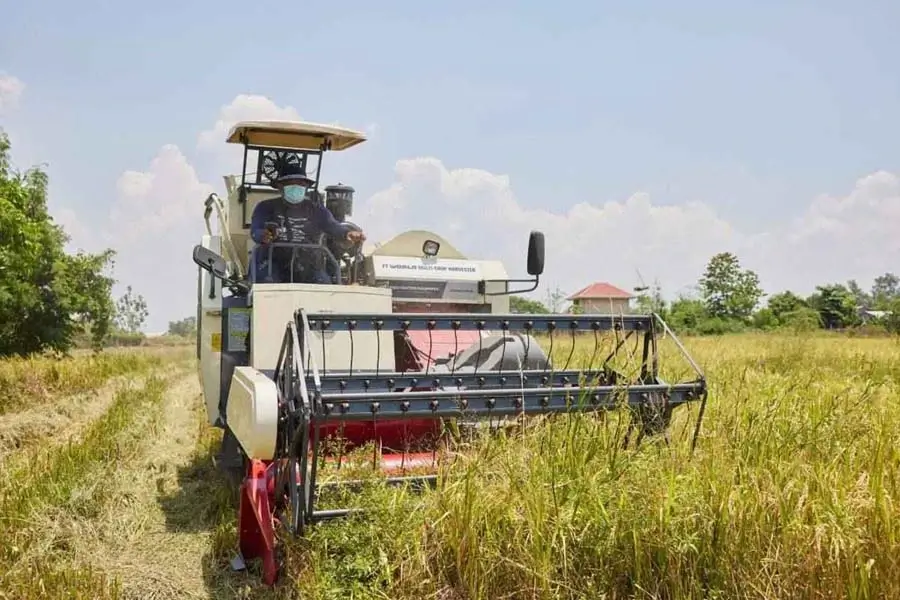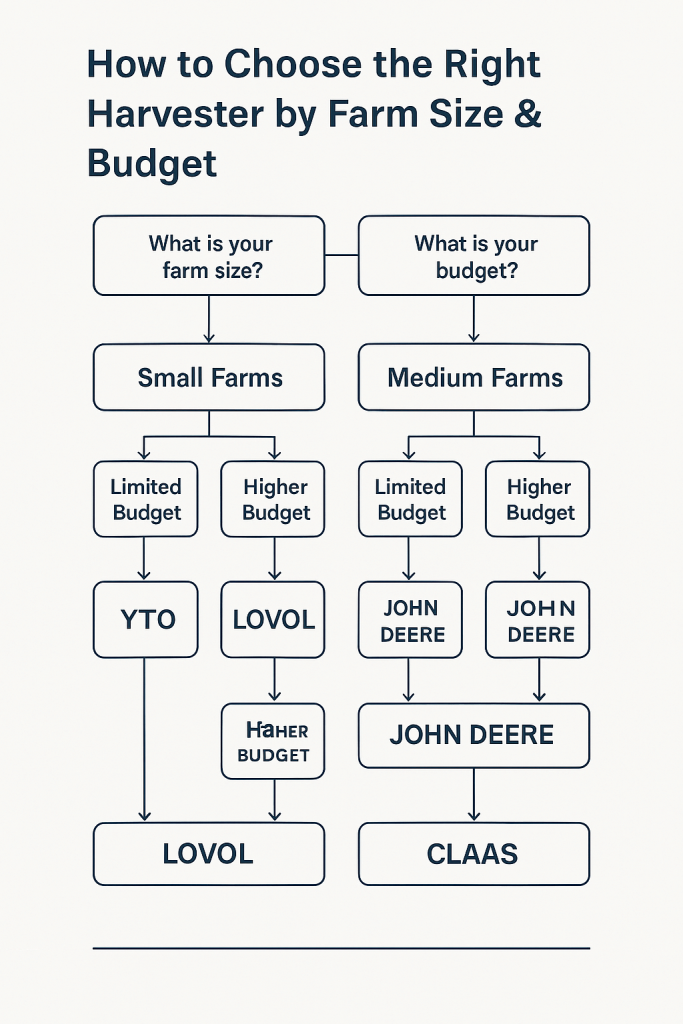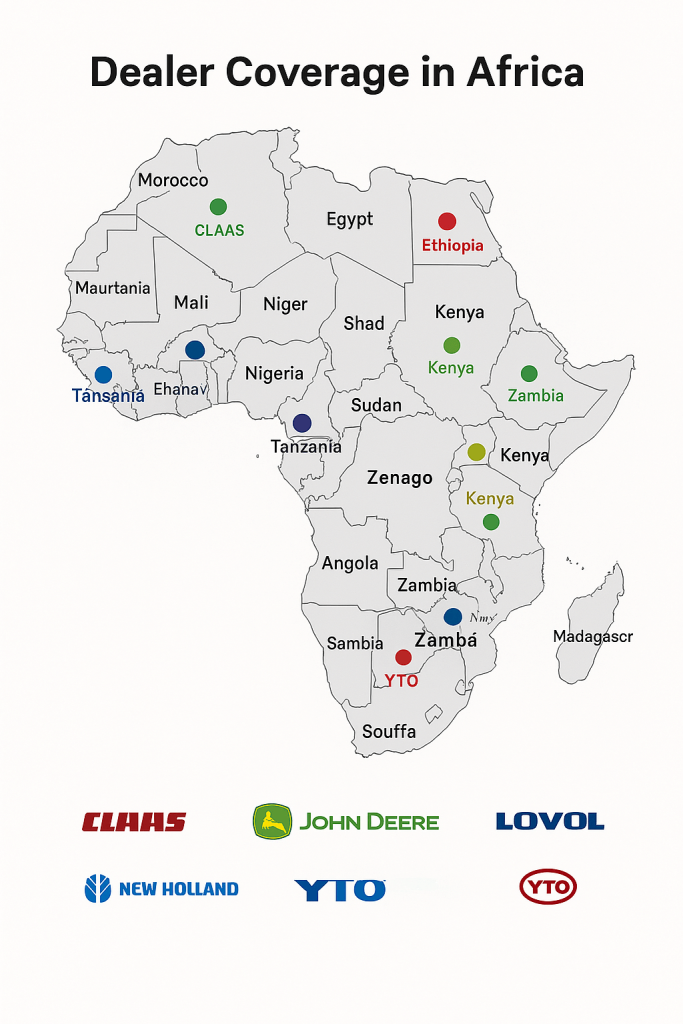In Africa’s fast-evolving agricultural landscape, maximizing crop yields while minimizing labor costs is more important than ever. Combine harvesters — powerful machines that integrate reaping, threshing, and cleaning — are playing a critical role in improving efficiency, reducing post-harvest losses, and supporting food security across the continent.
From expansive commercial farms in South Africa to cooperative fields in Nigeria and smallholder plots in Kenya, the right combine harvester can boost productivity, reduce manual labor, and increase profitability. In this comprehensive guide, we explore the top 5 combine harvester manufacturers that African farmers can rely on in 2025.
Contents
1. CLAAS (Germany)
Overview
CLAAS, headquartered in Germany, has long established itself as a technological pioneer in the agricultural machinery industry. Its combine harvesters are designed with precision engineering, catering to high-output, demanding harvest scenarios. CLAAS has steadily expanded its presence in Africa through collaborations, pilot projects, and dealer development, ensuring farmers can benefit from German quality even in remote rural areas.
✅ Key Strengths
LEXION and TUCANO series are renowned for their high-capacity throughput, enabling quick and clean grain harvesting across different crops.
These machines feature adaptive threshing systems, wide headers, and advanced sensors for optimal field performance.
CLAAS has made significant efforts to strengthen after-sales service and spare part access across African countries, notably Egypt, South Africa, and Ethiopia.
Ideal For
CLAAS harvesters are ideally suited for large commercial farms handling high-acreage maize or wheat cultivation. Their technology-driven approach is perfect for farms that already employ GPS mapping, field telemetry, and automated harvesting to streamline labor and improve margins.

2. John Deere (USA)
Overview
John Deere is one of the most iconic brands in agriculture, known worldwide for its durable, high-performance machinery. In Africa, the brand is trusted not only for the quality of its combines but also for the depth of its support network. The company’s presence in Sub-Saharan Africa has grown through public-private partnerships and distribution alliances, making it easier for farmers to access its machinery and services.
✅ Key Strengths
S-Series combines deliver high harvesting productivity, equipped with AutoTrac guidance and active yield calibration for intelligent decision-making.
Designed to withstand Africa’s harsh environmental conditions including high heat, dust, and varying terrain.
Backed by a continent-wide dealer and parts network that offers maintenance training, seasonal servicing, and operator support.
Ideal For
Farmers operating in East, West, and Southern Africa seeking proven reliability, cutting-edge precision tools, and long-term brand support. John Deere is particularly effective for operations transitioning to smart farming with yield mapping and cloud-based crop analytics.
3. LOVOL (China)
Overview
LOVOL is one of China’s largest agricultural equipment manufacturers and has become an affordable mechanization solution for many African farms. The brand has focused its efforts on low-to-mid range combines that are durable and cost-efficient. Its growing popularity in Africa is supported by partnerships with local distributors and investment in field testing under African farm conditions.
✅ Key Strengths
LOVOL harvesters are built with reinforced chassis and easy-to-operate controls, tailored to rough fields and variable harvest windows.
Their value lies in offering modern features at nearly half the cost of premium Western brands, which is ideal for price-sensitive markets.
Countries such as Nigeria, Ghana, and Tanzania are increasingly relying on LOVOL machines for scalable maize and wheat production.
Ideal For
Small to medium-scale farmers and agricultural cooperatives looking to transition from manual to mechanized harvesting. LOVOL is ideal for projects with limited budgets but strong ambitions to scale quickly with reliable equipment.

4. New Holland (Italy/USA)
Overview
New Holland, a subsidiary of CNH Industrial, has a long-standing presence in African agriculture and is respected for combining European engineering with field practicality. Their machines are engineered for both grain quality preservation and ease of use, even under less-than-ideal maintenance conditions. In Africa, New Holland is often associated with development programs and large-scale corporate farming ventures.
✅ Key Strengths
The CR Series combines use twin rotor threshing which minimizes grain loss while maintaining high processing speed.
Easy maintenance, fuel efficiency, and a simplified mechanical structure make these harvesters suitable for remote operations.
Wide compatibility with different headers allows farmers to use a single combine for multiple crop types and varying row widths.
Ideal For
Farmers and agribusinesses prioritizing balance between performance, grain quality, and ease of ownership. It’s also suitable for government-led mechanization initiatives aiming for long-term scalability.
5. YTO Group (China)
Overview
YTO is a leading Chinese manufacturer specializing in value-oriented agricultural machinery. It is known for developing simple and robust machines designed to meet the basic harvesting needs of emerging economies. YTO has gained a foothold in Africa through its inclusion in government aid programs and low-interest agricultural equipment financing schemes.
✅ Key Strengths
Machines are constructed with simplicity in mind, allowing for easier repairs and field-level servicing by local technicians.
Popular with government and NGO-led agricultural modernization efforts in countries like Ethiopia, Angola, and Uganda.
Easy availability of parts due to strategic trade ties and distribution hubs across West and East Africa.
Ideal For
Community-run farms, public agricultural training institutions, and NGOs looking to empower rural farmers with entry-level mechanization. YTO is a safe starting point for farmers unfamiliar with heavy equipment.

Harvester Selection Flowchart: Farm Size & Budget
Not sure where to start when choosing a harvester? We’ve created a simple visual guide to help. Our infographic, “How to Choose the Right Harvester by Farm Size & Budget,” walks you through key decisions based on the size of your farm and your available budget. Whether you’re managing a small cooperative field or running a large commercial operation, the flowchart leads you to the right choice—be it a reliable YTO or LOVOL for entry-level needs, or a more advanced CLAAS or John Deere for high-performance farming. It’s a helpful tool for farmers looking to make confident, well-informed equipment investments.

Distribution of harvester dealers in Africa
To help visualize where each harvester brand is most active across the continent, we’ve included a colorful map showing dealer coverage by country. Each brand—CLAAS, John Deere, New Holland, LOVOL, and YTO—is represented with its own color, and key countries such as Nigeria, Kenya, South Africa, Ethiopia, and Ghana are clearly marked with labeled dots. This makes it easy for farmers and buyers to see which manufacturers have a stronger local presence, giving them more confidence in access to service, spare parts, and technical support when choosing a combine harvester.

❓ Frequently Asked Questions (FAQ)
Q1: Which combine harvester is best for smallholder farms in Africa? A: LOVOL and YTO models are affordable, compact, and reliable—making them ideal for small farms and cooperatives.
Q2: What key features should I consider when buying a combine? A: Focus on crop type, field size, terrain, local fuel availability, parts support, and your ability to manage maintenance.
Q3: Do African countries have local after-sales service for these brands? A: Yes. John Deere, CLAAS, and New Holland have expanding dealer networks in East, West, and Southern Africa.
Q4: Can I import a combine harvester directly into my country? A: Yes. Work with authorized dealers or certified trading agents. Most offer shipping, training, and after-sales services.
Q5: Is it safe to buy used harvesters? A: It can be. Ensure it has verified service history, operational hours under 3,000, and confirm that parts are still available locally.
Related Equipment Recommendations
Grain Trailers: Partnered with large combines for safe and quick transport
Mini Rotary Tillers: Ideal for soil preparation prior to sowing
Moisture Meters: Ensures harvested grains are properly dried for storage
GPS Farm Mapping Systems: Helps track harvest coverage and yield
Precision Seeders: Enhance the planting cycle after harvest
If you’re looking to invest in your farm’s future, a high-quality combine harvester is one of the best steps forward. Whether you’re managing hundreds of hectares or running a smallholder operation, the right machine makes a world of difference.
Need help choosing? Contact our team today for personalized harvester recommendations and local distributor connections across Africa.
✅ Conclusion
Combine harvesters are no longer a luxury — they are an agricultural necessity for improving efficiency and crop profitability in Africa. The brands featured in this guide represent the best in global innovation and local adaptability.
Whether you’re a farmer in Ethiopia battling rocky terrain, a co-op in Ghana scaling up production, or a commercial grower in South Africa eyeing advanced automation, there’s a combine harvester built for your field.
Make the smart move this season — harvest better, faster, and smarter. For farms looking for tailored solutions, MINNUO agricultural machines offer reliable programs and equipment that help you get the most out of your harvest.

